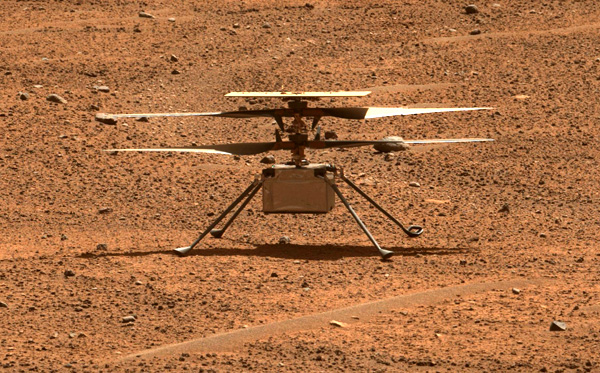
NASA / JPL - Caltech / ASU / MSSS
NASA’s Ingenuity Mars Helicopter Flies Again After Unscheduled Landing (News Release - August 7)
The helicopter performed a short hop to help the team better understand why its previous flight was interrupted.
NASA’s Ingenuity Mars helicopter successfully completed its 54th flight on August 3, the first flight since the helicopter cut its July 22 flight short. The 25-second up-and-down hop provided data that could help the Ingenuity team determine why its 53rd flight ended early.
Flight 53 was planned as a 136-second scouting flight dedicated to collecting imagery of the planet’s surface for the Perseverance Mars rover science team. The complicated flight profile included flying north 666 feet (203 meters) at an altitude of 16 feet (5 meters) and a speed of 5.6 mph (2.5 meters per second), then descending vertically to 8 feet (2.5 meters), where it would hover and obtain imagery of a rocky outcrop.
Ingenuity would then climb straight up to 33 feet (10 meters) to allow its hazard divert system to initiate before descending vertically to touch down.
Instead, the helicopter executed the first half of its autonomous journey, flying north at an altitude of 16 feet (5 meters) for 466 feet (142 meters). Then a flight-contingency program was triggered, and Ingenuity automatically landed.
The total flight time was 74 seconds.
“Since the very first flight we have included a program called ‘LAND_NOW’ that was designed to put the helicopter on the surface as soon as possible if any one of a few dozen off-nominal scenarios was encountered,” said Teddy Tzanetos, team lead emeritus for Ingenuity at NASA’s Jet Propulsion Laboratory in Southern California. “During Flight 53, we encountered one of these, and the helicopter worked as planned and executed an immediate landing.”
The Ingenuity team is confident that the early landing was triggered when image frames from the helicopter’s navigation camera didn’t sync up as expected with data from the rotorcraft’s inertial measurement unit. The unit measures Ingenuity’s acceleration and rotational rates – data that makes it possible to estimate where the helicopter is, how fast it is moving, and how it is oriented in space.
This was not the first occasion on which image frames were dropped by the helicopter’s Navcam during a flight. Back on May 22, 2021, multiple image frames were dropped, resulting in excessive pitching and rolling near the end of Flight 6.
After Flight 6, the team updated the flight software to help mitigate the impact of dropped images, and the fix worked well for the subsequent 46 flights. However, on Flight 53 the quantity of dropped navigation images exceeded what the software patch allows.
“While we hoped to never trigger a LAND_NOW, this flight is a valuable case study that will benefit future aircraft operating on other worlds,” said Tzanetos. “The team is working to better understand what occurred in Flight 53, and with Flight 54’s success we’re confident that our baby is ready to keep soaring ahead on Mars.”
Source: Jet Propulsion Laboratory
****

NASA / JPL - Caltech

No comments:
Post a Comment